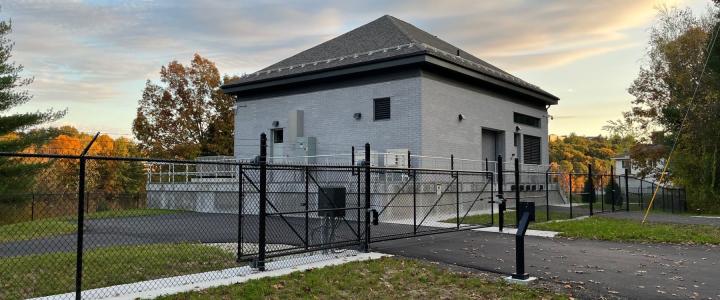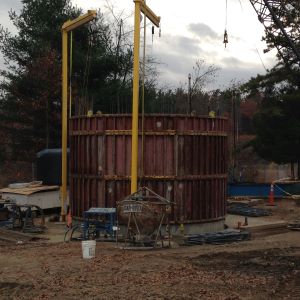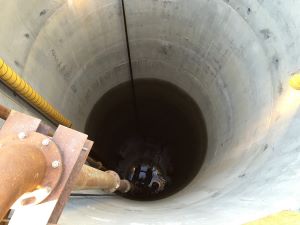
Manchester Water Works Completes First in New Hampshire Radial Collector Well
By James M. Wieck, P.G., Hydrogeologist/Associate Principal, GZA GeoEnvironmental, Inc. and
David G. Miller, P.E., Deputy Director, Water Treatment & Supply, Manchester Water Works
The Manchester Water Works (MWW) has completed development of a novel water source to help meet the south-central region’s water supply needs. The size and design of the source and the associated Source Water Protection Plan (SWPP) are unique in New Hampshire. Population growth, climate change, urbanization, and the loss of resources due to contamination all impact water supplies and our finite water resource. Interconnections and agreements between water suppliers create important resiliency and the opportunity for water suppliers to meet future needs. Additional sources, such as the one developed by MWW, are also needed to address the stresses on the existing supplies and meet future needs.
 New Hampshire’s south-central region is home to approximately 40% of the state’s population and, demands on water supplies are increasing. MWW currently supplies Manchester and six surrounding communities. The principal source of water for MWW has been Lake Massabesic, with a safe yield capacity of 20.2 million gallons per day (MGD) and an average of 18 MGD supplied to over 180,000 customers. Additionally, MWW has committed 3.13 MGD to the Southern New Hampshire Regional Water Project, which connects MWW to six additional towns.
New Hampshire’s south-central region is home to approximately 40% of the state’s population and, demands on water supplies are increasing. MWW currently supplies Manchester and six surrounding communities. The principal source of water for MWW has been Lake Massabesic, with a safe yield capacity of 20.2 million gallons per day (MGD) and an average of 18 MGD supplied to over 180,000 customers. Additionally, MWW has committed 3.13 MGD to the Southern New Hampshire Regional Water Project, which connects MWW to six additional towns.
MWW recognized the need for an additional water supply source and began hydrogeologic investigations in 2007 to identify resources. The results of investigations completed along the Merrimack River indicated the presence of sand and gravel deposits with the potential to supply a large volume of water. As a result, MWW opted to construct a Radial Collector Well (RCW), which had the added benefit of a significant level of pretreatment from a process known as riverbank filtration. The RCW consists of a 16-foot internal diameter caisson constructed onshore to a depth of approximately 70 feet, and six well screens that extend laterally up to 240 feet from the caisson in a fan-like pattern, with laterals running along and beneath the riverbed.
 The MWW RCW is the first well of this design used as a public water supply in New Hampshire. Its novel design takes advantage of the collective screen length of the laterals (1,180 feet), effective large diameter of the aggregate well, and the benefits of the filtration of surface water through the bank and riverbed. While the RCW is considered a groundwater source, withdrawal testing included long duration summer and winter tests to evaluate the effects of seasonal changes in surface water viscosity. The withdrawal testing included use of multi-level piezometers deployed within the riverbed and equipped with transducers and temperature sensors providing data in real-time. MWW was issued a permit by the New Hampshire Department of Environmental Services (NHDES) for the withdrawal of up to 7.2 MGD under the New Hampshire Large Groundwater Withdrawal Permit program.
The MWW RCW is the first well of this design used as a public water supply in New Hampshire. Its novel design takes advantage of the collective screen length of the laterals (1,180 feet), effective large diameter of the aggregate well, and the benefits of the filtration of surface water through the bank and riverbed. While the RCW is considered a groundwater source, withdrawal testing included long duration summer and winter tests to evaluate the effects of seasonal changes in surface water viscosity. The withdrawal testing included use of multi-level piezometers deployed within the riverbed and equipped with transducers and temperature sensors providing data in real-time. MWW was issued a permit by the New Hampshire Department of Environmental Services (NHDES) for the withdrawal of up to 7.2 MGD under the New Hampshire Large Groundwater Withdrawal Permit program.
Raw water from the RCW is delivered via a 20-inch pipeline to the recently completed Merrimack River Water Treatment Facility located approximately ¾-miles downstream. The water passes through greensand filters to remove trace dissolved iron and manganese followed by granular activated carbon (GAC) contactors for additional contaminant removal. Water then travels through ultraviolet (UV) reactors to provide primary disinfection for Giardia & Cryptosporidium. Following UV disinfection, sodium hypochlorite is added to satisfy remaining disinfection requirements before being converted to monochloramine for residual disinfection. Final chemical treatment includes sodium hydroxide and phosphoric acid for pH and corrosion control and fluoride for dental protection.
Based on surface water, groundwater and caisson water temperature data, much of the water withdrawn from the RCW is anticipated to be induced infiltrated surface water, and a SWPP that considers the hybrid nature of the RCW was prepared. The watershed of the RCW includes 2,814 square miles of the Merrimack River Watershed. The size of the watershed creates logistical challenges, which will be managed through the delineation of zones within the watershed. Along with the Wellhead Protection Area associated with the groundwater withdrawal, the SWPP includes an emergency response zone and outreach zones within which MWW will conduct public outreach to support source protection. Collaboration with municipalities and organizations within the watershed will be important to protect the resource.
After many years of planning and construction, the Merrimack River is now an active supplemental supply for MWW.




